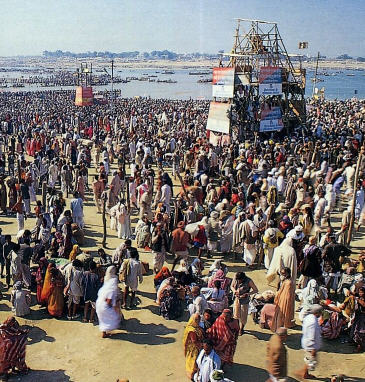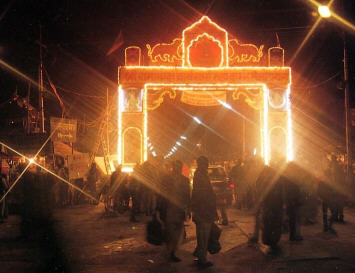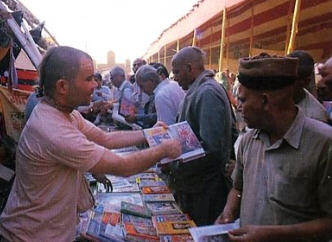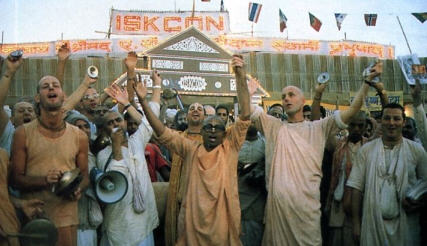You'll see just about everything at the Kumbha-mela. But unless you see or hear from a great soul, you won't be able to make sense of it all.
What could sixteen million saints and sadhus, sannyasis (renunciants) and businessmen, housewives and farmers, teachers and students, scientists and the superstitious, poets and politicians. mystics and beggars all have in common? The quest for immortality. What else could bring together such a multitude of individuals on one congested riverbank for forty days?
Besides being the largest gathering of human beings anywhere on earth, the Kumbha-mela can evoke the deepest spiritual sentiments of the Lord's pure devotees.
The Kumbha-mela is by far the largest religious phenomenon in which the collective destiny and spiritual urges of the human race find expression.Kumbha is a Sanskrit word meaning "pot" "pitcher," or "jar," and melameans "festival." Kumbha-mela gets its name, therefore, from the pot of immortalizing nectar around which the festival has grown.
Held at the confluence (sangam) of the three most holy rivers in India, the Ganges, the Yamuna, and the subterranean Sarasvati, the Kumbha-mela lures the faithful for a dip in the holy waters that relieves them of lifetimes of karmic reactions. There is a scriptural understanding that bathing on the astrologically propitious "peak" holy days extinguishes uncountable sins, relieving the pilgrim of his or her entanglement in the complex cycle of birth, disease, old age, and death. One can thus transcend the mortal world of perpetual reincarnation, of duality and suffering, and hasten one's return back home, back to Godhead.
A veritable sea of swaying bodies and heads moves inexorably to the confluence. Accompanied by the cacophonous clamor of bells, cymbals, horns, whooping, the shouting of invocations, and the constant blaring of devotional songs over a ubiquitous P.A. system, armies of ascetics and cityfolk alike cry out, "Bolo Ganga-mayi ki jaya! Sri Yamunamayi ki jaya! [All glories to the Ganges and Yamuna!]" creating a thunderous symphony of reverential incantation.

Kumbha-Mela
During the sacred bathing period, caste and racial divisions and the demarcations of various cults and sects dissolve, as one person assists the other in cleansing the body and the soul.
The Mela serves as a melting pot for more than eight thousand groups and religious institutions. Here they exchange philosophical ideas and share spiritual realizations. Some say the Mela is a symbol of Hindu unity, offering a means of transmitting the spiritual and ascetic values of ancient Vedic culture to the masses of devotees.
Cornered by Buddhism, Jainism, and Islam in the eighth century. Hindu civilization (more appropriately called Vedic civilization) was thought to be in danger of extinction. Therefore Sankaracarya, India's ninth-century religious reformer (and, according to the Puranas, an incarnation of Siva), instituted at the Kumbha-mela regular summit meetings of spiritual leaders as a buttress for the survival of Vedic theism. Some say that it was Sankaracarya who started the Kumbha-mela, but scriptural references about the Mela predating Sankara prove such a theory inaccurate.
The Mela has become a forum by which the saintly and self-realized impart by example mystical and moral codes to the devoted. Alongside enlightened spiritual masters, however, fakes and frauds abound.
The Kumbha-mela has had a magnetism for saints and scholars for thousands of years. As early as 302 B.C. the great Greek historian Megasthenes documented his seventy-five-day stay at Prayaga (Allahabad), during a Mela that boasted an attendance of two and a half million. Later, in the seventh century A.D., the pious emperor Harsha invited the eminent Chinese mendicant Hieun Tsang to join in the festivities. In his journals Tsang praised the emperor's exemplary spiritual leadership:
"The festival concluded with Harsha's lavishly distributing all of his accumulated wealth to the needy, down to his robes, and returning to his palace in clothes borrowed from his sister."
Other, more recent celebrities recorded their realizations:
Mark Twain wrote in More Tramps Abroad (1895):
These pilgrims had come from all over India: some of them had been months on the way, plodding patiently along in the heat and dust, worn poor, hungry, but supported and sustained by an unwavering faith and belief. It is wonderful, that the power of faith like that can make multitude upon multitudes of the old and weak and the young and frail enter without hesitation or complaint upon such incredible journeys and endure the resultant miseries without repining. It is done in love or it is done in fear. I do not know which it is. No matter what the impulse is, the act born of it is beyond imagination, marvellous to our kind of people, the cold whites. There were "facquirs" in plenty with their hair caked with cow dung. There was a holy man who sat naked by the day and by the week on a cluster of iron spikes and did not seem to mind it. And another man stood all day holding his withered arms motionless aloft and was said to have been doing it for years. All these performers have a cloth on the ground beside them for receipt of contributions, and even the poorest of the poor give a trifle and hope that the sacrifice will be blessed to them. At last came a procession of naked holy people marching by and chanting, and I wrenched myself away. . . . The memory of that sight will always stay with me, but not by request.

Mohandas K. Ghandi irritated over how the original zeal and pristine mood of the Mela had in some ways dissipated and given way to an exhibition of hollow spirituality, remarked in 1915, "The swarm of sadhuswho descend seem to have been born to enjoy the good things in life."
Like any fair, the Kumbha-mela isn't without its dangers. For some it can be a pseudo-spiritual jamboree, where money-hungry pandas (ritualistic priests) will dance for your patronage and promise you heavenly benedictions; and where commerce confidently competes with transcendence. Boatmen navigating overloaded taxis to the sangam grab at the gullible as well as the savant, guaranteeing untold pious credits in exchange for their extortionary fees.
The Mela is an ancient crucible of rite and spectacle, of colorfully immoderate religious pageantry, murky beliefs, and flamboyant Hindu fervor. That fervor, historically and inordinately mixed with the pandemonium of so many pilgrims, has sometimes wreaked tragedy. In 1760, in a hysterical dash for atonement at the Triveni ("three rivers")sangam during the zenith bathing hour, the gathering exploded into a small-scale war. Maddened sects of sannyasis owing their allegiance to either Visnu or Siva clashed over the right to bathe first. Swashbuckling, ash-covered svamis brandishing iron tridents, maces, swords, and chains punctured and pummeled errant pilgrims infringing on their priority. Ever since then, the Naga-babas, or naked Siva-worshipers known for their fiery protocol, have taken the elite position of being the first to dip.
At Prayaga the celebration occurs during the month of Magha (January-February), and the highest merit is attached to bathing on the new-moon mornings. Jupiter is then in the house of Taurus, and both the sun and moon are in Capricorn.
Years in preparation, the 1989 Purna ("full") Kumbha-mela has been a major expense for the Indian government. Festival arrangements require a major cityplanning commission to provide for an estimated sixteen million pilgrims. The government provided 1070 hectares of land (2,644 acres) to accommodate the temporary city.
Sridhara Swami of ISKCON Bombay describes the elaborate construction: "Like a sand castle on the seashore that is soon to be washed away by the waves, the Kumbha-mela puri (city) manifests, with hundreds of thousands of residential tents, hospitals, shopping areas, 170 kilometers of drinking-water piping, and even a temporary railway station."
Nine pontoon bridges and over a hundred miles of temporary roads crisscrossed the Triveni area.
ISKCON'S Contribution
Sri J. N. Dvivedi, the official in charge of the entire Mela and an avid ISKCON supporter, allocated five acres of the choicest land to the Hare Krsna devotees. Replete with spacious stages, colorful pandals (circus-size tents), bathrooms, showers, kitchens, and luxury and economy residential tents, the ISKCON site was a powerful magnet for both the seasoned pilgrim and the newcomer.

The sangam was a fifteen-minute walk from camp. and the Hare Krsna devotees participated in the festival by enthusiastically chanting the Lord's holy names and distributing tens of thousands of transcendental books and more than 250,000 free plates of krsna-prasadam. The cooking was done in six mammoth cast-iron woks, each four feet in diameter and weighing about four hundred pounds.
The managerial pillars of the ISKCON camp, Bhakti Raghava Swami, Ayodhya-pati dasa, Tattva-darsana dasa, and Adridharana dasa, worked tirelessly to coordinate and maintain the colossal endeavor. Hundreds of devotees were busy around the clock in different ways, joyfully cooking, distributing books, chanting, and accommodating the two thousand guests residing at the ISKCON colony.
The magnum opus of the ISKCON site was the multimedia exhibits. Eight larger-than-life museum-quality diorama sculptures depicting different pastimes of the Lord in His various incarnations attracted tens of thousands of awe stuck audiences daily. By observing these art forms of Krsna, Sri Caitanya Mahaprabhu, and Lord Ramacandra, pilgrims witnessed the glorious nature of pure devotional service propounded by the Brahma-Madhva-Gaudiya-sampradaya, an ancient lineage of Krsna conscious teachers.
Devotees from around the world went to great pains to share Krsna conscious multimedia projects with the pilgrims. Krsna-prema dasa and his wife, Nitya-trpta-devi dasi of Italy orchestrated a nine-projector, computer-monitored visual production that showed on a thirty-foot by sixty-foot screen. Called "Krsna Vision," it depicted the history and character of Srila Prabhupada and the purpose of ISKCON. Hundreds of thousands of pilgrims were mesmerized with this electrifying presentation of the wisdom of Krsna consciousness. Many pilgrims stayed in the Krsna Vision tent nearly all day long relishing the multifaceted artistic portrayal of Krsna consciousness created by the intense musical sensations of Krsna-prema and the dynamism of Nitya-trpta's camera wizardry.
Many guests and pilgrims, and even those with their own tents, declared that the ISKCON site was the most exciting and meaningful one at the fair and that it offered the most edifying transcendental association. ISKCON's question-and-answer booth was a welcome respite for the many bewildered and curious pilgrims. One visitor remarked that the ISKCON question-and-answer booth was the only one of its kind, and that to hear the answers of Dina-bandhu dasa, ISKCON Vrndavana's temple president, was like finding water in the desert.

The all-pervading public address system never rested once throughout the six weeks of the festival. For most it was an annoyance that disturbed sleep and harassed the eardrums. But one intelligent 1SKCON sannyasi,Nava-yogendra Swami, took advantage of this surfeit to spread Krsna consciousness. He was able to get use of the P.A. system to broadcast the chanting of the holy names for several hours each day.
One visitor, Mrs. Jaya Srivastava, professor of mathematics at Colorado State University and a world leader in the field of statistics, remarked,
I am very pleased that ISKCON is so positively influencing India and the world. Man does not live by bread alone but by every word of God. Therefore this gathering is wonderful because it attracts the minds of millions to the spiritual side. And without that we're just as Srila Prabhupada said: "merely sophisticated animals" eating, sleeping, mating, and defending. Material problems will always be there, so we need to do something to elevate ourselves spiritually. Therefore ISKCON is praiseworthy, organizing such an opportunity for millions to become purified. Even if I were an atheist, I would still praise ISKCON.
The ISKCON devotees who participated in the Kumbha-mela expressed their appreciations for the enthusiastic devotional service rendered by Srila Prabhupada's followers. Their appreciations reveal that they were experiencing what Srila Prabhupada had pointed out to be the essence of the Mela. In 1977, on hearing an ISKCON life member dispute the detailed history and alleged purpose of the Kumbha-mela, Srila Prabhupada interrupted sternly "This is not very important. The real significance of the Kumbha-mela is sadhu-sanga, the association of saintly persons, devotees."
by Jagannatha Krsna Dasa

No comments:
Post a Comment